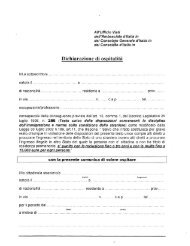Investment in Italy
Investment in Italy
Investment in Italy
- No tags were found...
You also want an ePaper? Increase the reach of your titles
YUMPU automatically turns print PDFs into web optimized ePapers that Google loves.
<strong>Investment</strong> <strong>in</strong> <strong>Italy</strong>1.2Snapshot of the Italian economy1.2.1Ma<strong>in</strong> macro-economic <strong>in</strong>dicators for <strong>Italy</strong>: 2005-2010Ma<strong>in</strong> economic <strong>in</strong>dicators2005 2006 2007 2008 2009 2010(e)GDP (eur bln) 1,245 1,271 1,288 1,271 1,207 1,219GDP (YoY changes) 0.8% 2.1% 1.4% -1.3% -5.1% 1.00%Unemployment rate (% labour force) 7.7% 6.8% 6.2% 6.7% 7.8% 8.4%Average nom<strong>in</strong>al wages <strong>in</strong>flation 2.7% 3.4% 2.8% 3.4% 3.2% 2.2%Labour cost per hour (eur) 19.5 20.0 20.6 21.3 21.9 22.4Consumer price <strong>in</strong>dex 2.2% 2.2% 2.0% 3.5% 0.8% 1.5%Export of goods (% change) 2.0% 6.5% 3.9% -3.9% -19.1% 6.4%Import of goods (% change) 2.7% 6.2% 3.3% -4.3% -14.6% 5.2%Source: Economist Intelligence Unit1.2.2Key <strong>in</strong>dustries overviewThe Italian economy is characterised by 4.4 million highly dynamic firms operat<strong>in</strong>g <strong>in</strong> manydiversified <strong>in</strong>dustries. The vast majority of these are small and medium-sized enterprises(SMEs), while approximately 3,400 firms only are considered large companies with morethan 250 employees. While the presence of a vast majority of SMEs is a common feature ofmany European economies, a peculiarity of Italian <strong>in</strong>dustry is the presence of a large numberof micro-firms: approximately 95 percent of companies have less than n<strong>in</strong>e employees, 3percent of companies have 10 to 19 employees and approximately 79,000 companies employmore than 20 people (source: ISTAT). <strong>Italy</strong> can be geographically split <strong>in</strong>to an <strong>in</strong>dustriallydeveloped northern region, dom<strong>in</strong>ated by private companies, and the less developed south,with a high rate of unemployment.The service sector is a major contributor to the Italian economy. It accounts for approximately73 percent of GDP and is also the fastest grow<strong>in</strong>g segment. Tourism, retail and f<strong>in</strong>ancialservices represent a significant part of the sector.The <strong>in</strong>dustrial sector accounts for approximately 25 percent of GDP with the rema<strong>in</strong>dercontributed by agriculture (source: L’Italia <strong>in</strong> cifre, ISTAT, 2010). Motor vehicles, fashionand luxury goods, life science, aerospace, chemicals, <strong>in</strong>formation and communicationtechnology, logistics, renewable energy, and precision mach<strong>in</strong>ery are among the mostimportant sectors of Italian manufactur<strong>in</strong>g.Some of the key Italian sectors are described below.© 2012 KPMG S.p.A., KPMG Advisory S.p.A., KPMG Fides Servizi di Amm<strong>in</strong>istrazione S.p.A., KPMG Audit S.p.A., Italian limited liability share capital companies, and Studio Associato Consulenza legale e tributaria, anItalian professional partnership, are member firms of the KPMG network of <strong>in</strong>dependent member firms affiliated with KPMG International Cooperative (“KPMG International”), a Swiss entity. All rights reserved.11
















